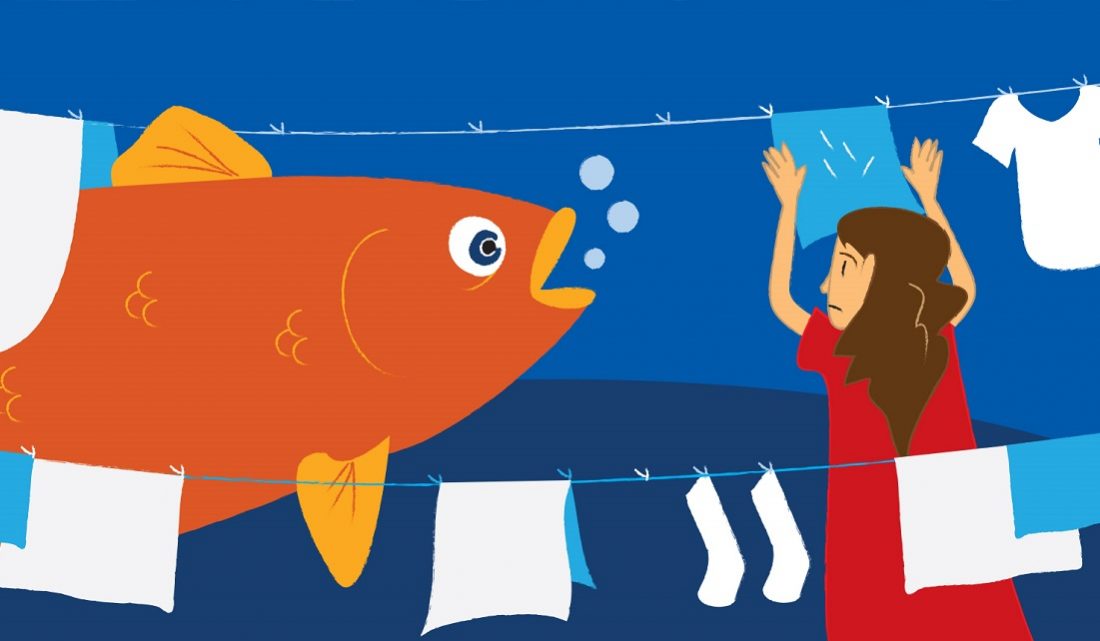
As you dine on locally-caught fish, you probably aren’t thinking of that old acrylic sweater or fleece jacket that you wear and wash frequently. But it turns out that they may be on your plate. Illinois-Indiana Sea Grant-funded researchers have found microplastic fibers that come from clothing and other sources in the water, in sediment and in fish in three major rivers that flow into Lake Michigan.
Loyola University Chicago biologists John Kelly, Tim Hoellein and Rachel McNeish are assessing levels of microplastic using a range of measures. As part of a larger study, they collected samples from the mouths of the Muskegon, Milwaukee and St. Joseph rivers seasonally over the course of 2016 and into 2017.
“We found that 99 percent of the microplastic is fibers, and microfibers are everywhere,” said McNeish, a post doc who implemented the project. “Much of what we found is acrylic, polyester, and polyethylene, which comes from plastic bags.” These plastics break down to microscopic size in the water due to physical abrasion, sunlight and freezing.
While water sampling is typically done using nets, the Loyola team also sampled water directly. “We started doing these grab samples, we just fill up a liter container and bring it back and filter it, and we found particles smaller than 300 microns, the pore size of the nets,” said Kelly. “The smaller you go, the more numerous the pieces of plastic there are.”
The three rivers in this study have provided insight into the effect of how we use the land on how much microplastic is in the environment, which was a key goal of this project.
The most northern river, the Muskegon, which flows through land dominated by forests had less microplastic than the other two rivers, as one might expect. Moving south to more populated and developed areas, are the St. Joseph River, in a farm-rich watershed, and the Milwaukee River, which sits in a mixed, urban and agricultural region. The researchers found that both agriculture and urban land uses contribute significantly to the abundance of microplastic in these Lake Michigan tributaries.
“Ultimately what we really want to do is predict what aspects of our development or features of the landscape pose bigger problems when it comes to contributing microplastic to the landscape,” said Hoellein. “And we need to understand where microplastic accumulates the most, because if we don’t answer those questions, we’re not really in a good position to come up with a solution or even address the problem.”
The researchers also sampled 74 fish from the shallow waters of these three rivers and 85 percent of them, including bass and other sportfish, contained microplastic in their digestive tract, averaging 13 particles. They found that the amount of microplastic in individual fish was not a reflection of how much plastic was in the water—fish from all three sites had similar numbers of microfiber in their digestive system.
How much microplastic shows up in one fish versus another can better be explained by looking at the food web. The researchers found that fish that eat insects and other invertebrates, which may already contain microplastic, have more fibers than those that eat plants.
“Microplastic is interacting with aquatic wildlife,” said McNeish. “Fish are consuming it—either actively eating it thinking its food, eating insects with microplastic in them or maybe just drinking water with microplastic. Or they may consume it through contact with sediment. In any case, microplastic is entering the food web.”
“And as these three rivers drain into Lake Michigan,” she explained, “the movement of microplastic can happen with the rivers’ currents, but also through the migration of animals.”

